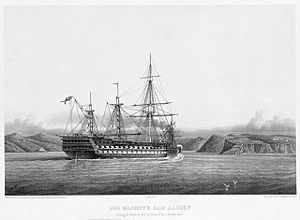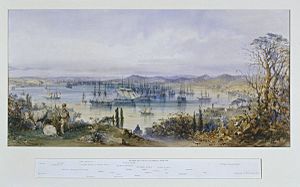HMS Albion (1842) facts for kids

HMS Albion entering the Bosphorus, partially dismasted after the action of 17 October 1854.
|
|
Quick facts for kids History |
|
|---|---|
| Name | HMS Albion |
| Ordered | 21 June 1839 |
| Builder | Plymouth Dockyard |
| Laid down | 13 August 1839 |
| Launched | 6 September 1842 |
| Completed | 23 January 1844 |
| Fate | Broken up, 1884 |
| General characteristics | |
| Class and type | Albion-class ship of the line |
| Displacement | 4,000 tons (4064.2 tonnes) |
| Tons burthen | 3,111 tons bm |
| Length | 204 ft (62 m) (gundeck) |
| Beam | 60 ft 2.5 in (18.352 m) |
| Depth of hold | 23 ft 8 in (7.21 m) |
| Propulsion | Sails |
| Sail plan | Full-rigged ship |
| Complement | 800 officers and men |
| Armament |
|
HMS Albion was a large sailing warship with 90 guns. She was part of the Royal Navy, which is the United Kingdom's navy. The ship was ordered in 1839 and built at Plymouth Dockyard. She was launched on September 6, 1842, and finished on January 23, 1844.
Albion was designed by Sir William Symonds. She was special because she was the only ship of her kind to serve only with sails. She was also the last large British warship with two gun decks to be built without a steam engine. Albion was the first ship in a group of three similar warships.
Contents
Life and Service of HMS Albion

HMS Albion began her service in 1844. She was sent to the Black Sea during the Crimean War. This was a big conflict involving several countries. In August 1854, many of her crew became sick with Cholera. This was a serious disease that caused many casualties.
Fighting in the Crimean War
Albion played a role in the siege of Sevastopol. This was a long battle where Allied forces tried to capture the city. Her commanding officer, Captain Stephen Lushington, led a special group called a Naval Brigade. This group helped the soldiers on land by providing heavy artillery. They used large guns from the ships to support the attack.
On October 17, 1854, Albion joined over 50 British and French warships. They launched a big attack from the sea on Sevastopol. The Russian forces suffered many losses, but the Allied ships did not cause much damage to the city's defenses.
Battle Damage and Recovery
The Allied fleet also took some hits from the Russian guns. Albion was set on fire three times during this battle. She had 11 crew members killed and 71 injured. Without the help of tugboats, Albion might have crashed into the shore. On August 17, 1855, Albion took part in another attack on Sevastopol.
What Happened to HMS Albion?
From 1860 to 1861, there were plans to change Albion to use a steam screw propulsion system. This work was done at Devonport, but the changes were never fully completed.
Albion was kept in reserve at Devonport for more than twenty years. This means she was ready to be used if needed, but she wasn't actively sailing. Finally, in 1884, the decision was made to take her apart. She was broken up at Devonport.
Images for kids


